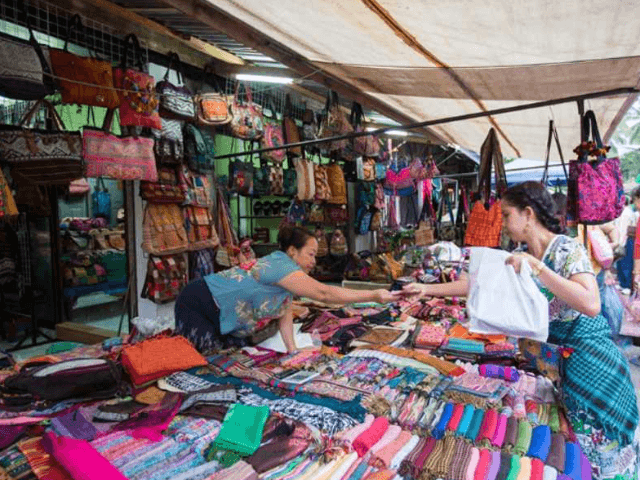Explore the serene Buddha Park, a unique blend of art, spirituality, and tranquility along the Mekong River. Admire its intricate sculptures, embrace Buddhist and Hindu symbolism, and reflect on its spiritual essence. Ideal for families and cultural enthusiasts, guided tours can enhance your experience. Combine your visit with other attractions in Vientiane for a memorable Laos adventure!
TABLE OF CONTENTS
1
Introduction to the Buddha Statue Garden
What Is the Buddha Statue Garden?
The History and Origins of This Spiritual Marvel
2
Location and How to Get There
Transportation Options to Reach the Garden
3
Highlights of the Buddha Statue Garden
1. Unique Buddhist and Hindu Sculptures
2. Spiritual Significance
3. Photography Opportunities
4
Best Time to Visit the Buddha Statue Garden
Seasonal Insights for an Optimal Experience
Weather Tips for Comfortable Sightseeing
5
Visitor Information and Tips
Entry Fees and Operating Hours
What to Wear – Respecting Local Customs
Things to Carry for Your Visit
6
Cultural and Historical Context of the Garden
The Vision of Luang Pu Bunleua Sulilat – The Creator of the Garden
Blend of Myths and Religious Narratives in the Sculptures
Insights into Lao Spiritual Practices Reflected in the Art
7
Nearby Attractions to Explore
Mekong Riverside – A Relaxing Spot Nearby
Vientiane’s Must-See Temples and Markets
Local Restaurants for Authentic Lao Cuisine
8
Sustainable Tourism Practices at the Buddha Statue Garden
Supporting Preservation Efforts Through Responsible Tourism
Dos and Don’ts to Respect the Spiritual Site
9
Conclusion – Why the Buddha Statue Garden Is a Must-Visit
A Blend of Art, Spirituality, and Tranquility
Final Tips for an Enriching Experience
10
FAQs About the Buddha Statue Garden
Is the Buddha Statue Garden suitable for families?
Are guided tours available at the site?
Can you combine the Buddha Garden visit with other Laos attractions?
Introduction to the Buddha Statue Garden
The Buddha Park, also known as Xieng Khuan (meaning "Spirit City"), is a unique and intriguing sculpture park located near Vientiane, Laos. It's a popular destination for tourists seeking a glimpse into Lao spiritual traditions and artistry. Filled with over 200 religious and mythical statues, the park offers a fascinating, albeit slightly surreal, experience.
What Is the Buddha Statue Garden?
The Buddha Park isn't a traditional temple garden. Instead, it's a collection of Buddhist and Hindu sculptures crafted from concrete. These figures depict various deities, demons, humans, and animals, all intertwined with symbolic representations of Buddhist and Hindu cosmology. Visitors can wander amongst giant Buddhas, fearsome demons, and curious mythical creatures, creating a truly memorable experience. A prominent feature is a large, spherical structure that can be entered, symbolizing the cycle of rebirth. Inside, visitors climb through three levels representing hell, earth, and heaven.
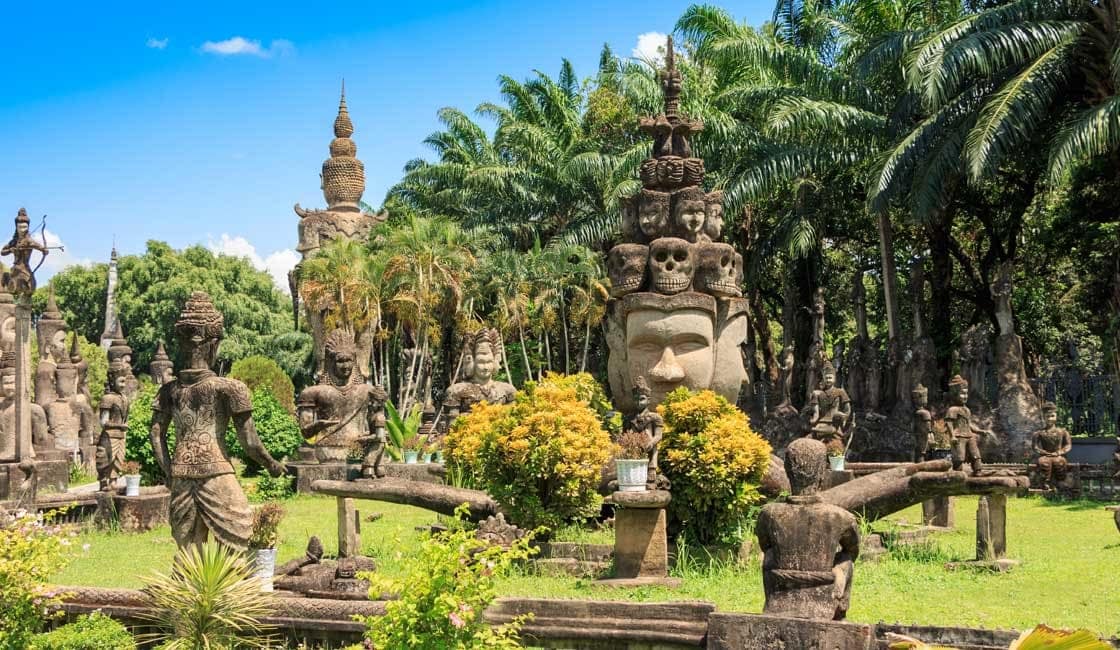
The History and Origins of This Spiritual Marvel
The park was created in 1958 by Luang Pu Bunleua Sulilat, a shaman who combined elements of Buddhism and Hinduism in his spiritual practice. His unique vision led to the creation of these striking sculptures, each imbued with symbolic meaning. Following the communist takeover of Laos in 1975, Bunleua Sulilat fled to Thailand where he built another, similar park called Sala Keoku near Nong Khai, just across the Mekong River from Laos. While the two parks share a similar aesthetic and creator, they are distinct entities.
The Buddha Park continues to be a place of fascination and reflection. It offers a unique window into Lao spiritual beliefs and artistic expression, making it a must-see for travelers interested in exploring the cultural richness of Laos.
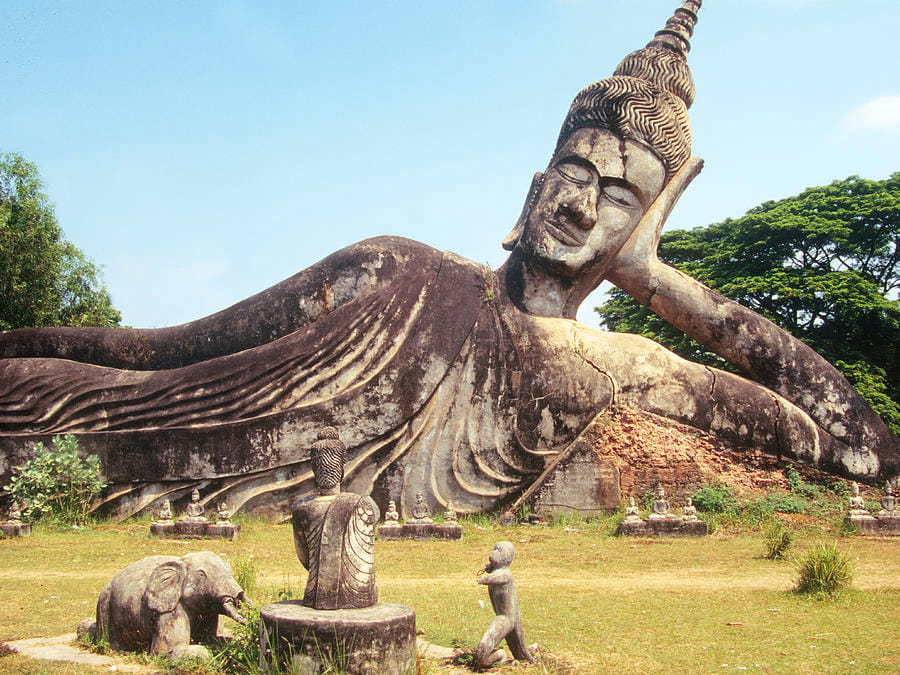
Location and How to Get There
Where Is the Buddha Statue Garden Situated?
The Buddha Park, also known as Xieng Khuan (Spirit City), is located approximately 25 kilometers southeast of Vientiane, the capital city of Laos. It sits on the banks of the Mekong River, close to the Friendship Bridge that connects Laos and Thailand.
Transportation Options to Reach the Garden
From Vientiane to the Buddha Park (Xieng Khuan)
Several options are available for reaching the park from Vientiane:
- Tuk-tuk: Negotiate a price beforehand. This is a common and relatively inexpensive option, though the journey can be dusty and bumpy.
- Taxi: More comfortable than a tuk-tuk, but also more expensive. Again, agree on the fare before starting your trip.
- Bus: Public bus number 14 runs from Vientiane's Talat Sao (Morning Market) to the Friendship Bridge. From there, you can take a short tuk-tuk ride to the park. This is the most economical option.
- Private Car: Hiring a car with a driver offers the most comfortable and convenient option, especially for larger groups.
Travel Tips for a Comfortable Journey
- Start Early: Visiting the park in the cooler morning hours is recommended, especially during the hot season.
- Negotiate Prices: Always agree on the fare with tuk-tuk and taxi drivers before starting your journey.
- Carry Water: Stay hydrated, particularly during hotter months.
- Sunscreen and Hat: Protect yourself from the sun.
- Local Currency: Have Lao Kip on hand for entrance fees and smaller purchases.
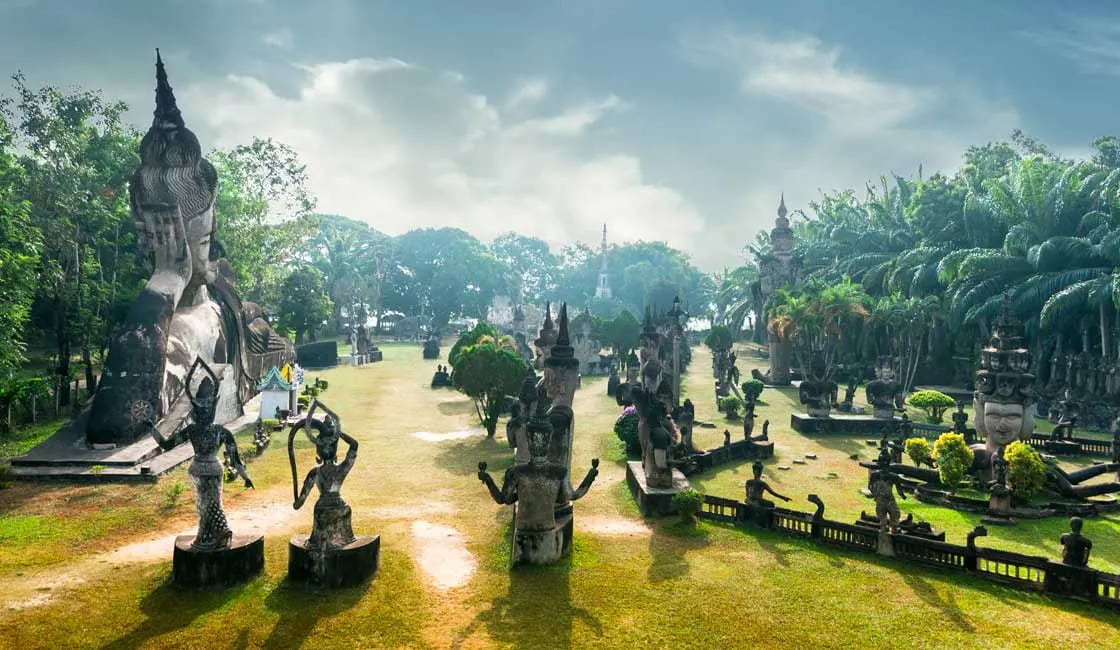
Highlights of the Buddha Statue Garden
1. Unique Buddhist and Hindu Sculptures
The Buddha Park's main draw is its diverse collection of over 200 sculptures, depicting figures from both Buddhist and Hindu traditions. This blend of religious influences creates a unique and fascinating atmosphere.
The Reclining Buddha Statue – A Symbol of Serenity
One of the most prominent sculptures is a large reclining Buddha, representing the Buddha's parinirvana (passing into final nirvana). Its serene posture evokes a sense of peace and tranquility.
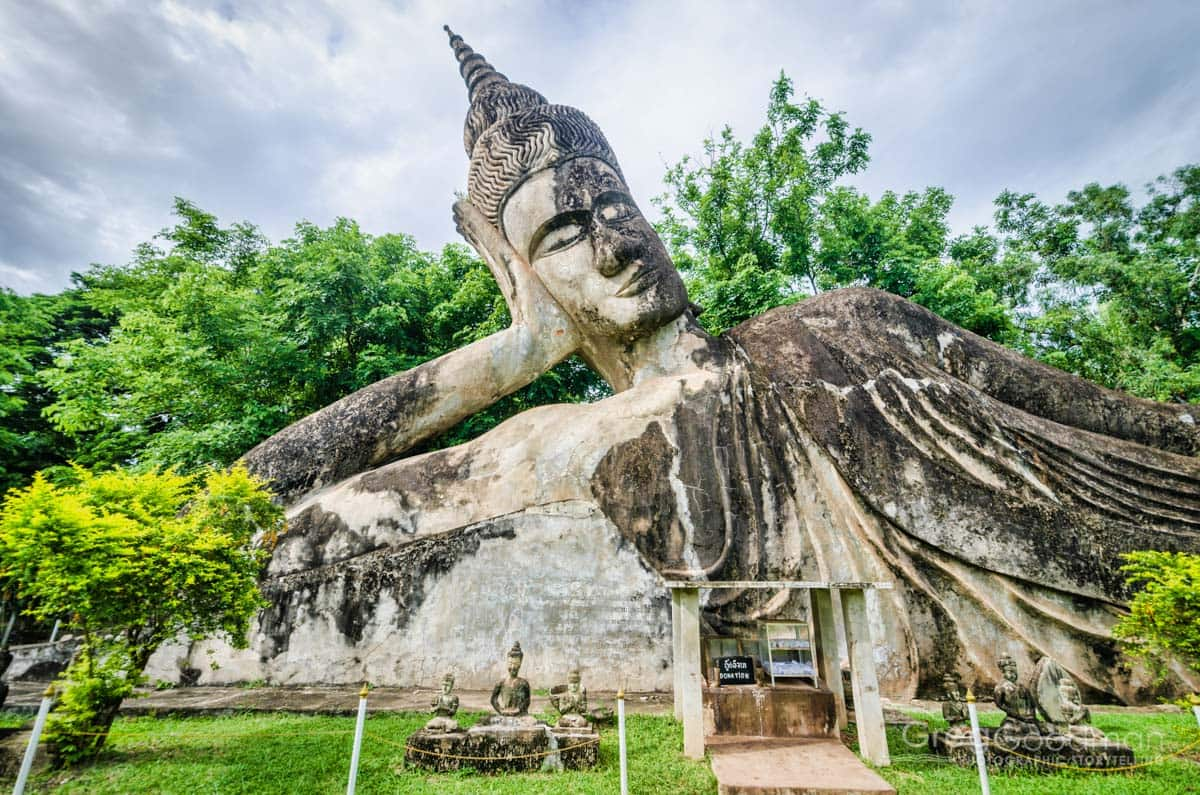
The Tower of Hell, Earth, and Heaven – A Journey Through Realms
A striking three-story spherical structure, often referred to as the "Pumpkin Tower," symbolizes the cycle of rebirth. Visitors can enter and climb through its levels, representing hell, earth, and heaven. Each level is filled with sculptures depicting the respective realm, offering a visual representation of karmic consequences and the path to enlightenment. The climb can be challenging due to narrow passages and steep stairs.
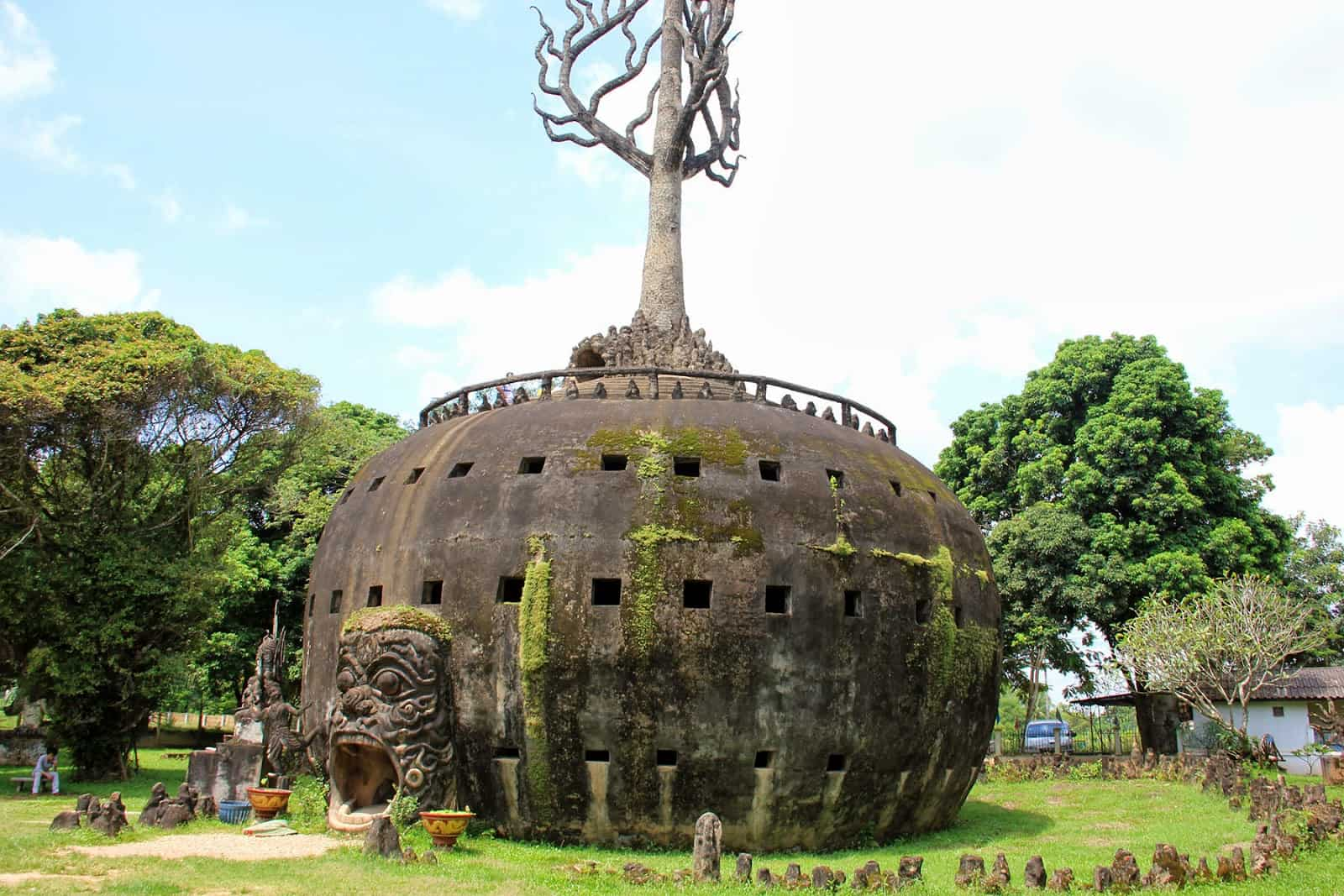
Mysterious and Symbolic Sculptures to Discover
Beyond these key figures, the park is filled with a multitude of other intriguing sculptures. Many depict Hindu deities, demons, and mythical creatures, each with its own symbolic meaning. Exploring the park and discovering these hidden gems is part of the experience. Some sculptures are whimsical, others are fearsome, and all contribute to the park's unique atmosphere. Taking time to appreciate the details and symbolism of each sculpture enriches the visit.
2. Spiritual Significance
The Buddha Park offers more than just visual appeal; it carries a distinct spiritual significance, reflecting the unique vision of its creator.
The Fusion of Buddhist and Hindu Philosophy
The park showcases a fascinating blend of Buddhist and Hindu philosophies, evident in the diverse range of sculptures. This fusion reflects the syncretic nature of religious beliefs in the region, where elements of different traditions often intertwine. While Buddhism is the dominant religion in Laos, Hindu influences are also present, particularly in folklore and traditional practices. The park's creator, Luang Pu Bunleua Sulilat, incorporated both traditions into his worldview, resulting in this unique collection.
How the Garden Inspires Meditation and Reflection
The serene setting along the Mekong River, combined with the symbolic nature of the sculptures, creates an atmosphere conducive to contemplation. While not a traditional temple, the park offers a space for quiet reflection on themes of life, death, and the journey to enlightenment. The diverse figures, representing various aspects of human experience and spiritual belief, can spark introspection and deeper understanding. The park encourages visitors to connect with their own spirituality, regardless of their religious background.
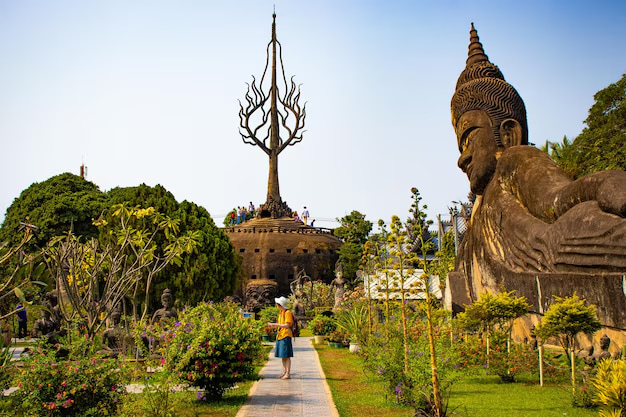
3. Photography Opportunities
Best Angles for Capturing the Majestic Sculptures
- Close-ups: Get up close to individual sculptures to capture their intricate details and textures. Focus on the expressions of the figures and the symbolism they represent.
- Wide Shots: Step back to capture the grandeur of larger sculptures, like the reclining Buddha, or to showcase the park's overall layout and the relationship between different figures.
- Perspective Play: Experiment with different angles and perspectives to create dynamic and interesting compositions. Use the surrounding foliage and the Mekong River as backdrops to enhance your photos.
- Inside the "Pumpkin Tower": Capture the unique views and sculptures within the three levels of this symbolic structure. The interplay of light and shadow can create dramatic effects.
Sunrise and Sunset Views at the Garden
The park's location on the Mekong River offers stunning sunrise and sunset views. These times of day provide soft, golden light that bathes the sculptures, creating a magical atmosphere.
- Sunrise: Capture the sculptures awakening with the first rays of sunlight, casting long shadows across the park.
- Sunset: Witness the sculptures silhouetted against the vibrant colors of the setting sun, reflecting on the Mekong River.

Best Time to Visit the Buddha Statue Garden
Seasonal Insights for an Optimal Experience
- Cool Season (November to February): This is the most popular time to visit Laos, and Buddha Park is no exception. The weather is dry and comfortable, with cooler temperatures ideal for exploring outdoors.
- Hot Season (March to May): Temperatures can be very hot and humid during this period. While fewer crowds are a plus, the heat can make sightseeing less enjoyable. Visiting early in the morning or late in the afternoon is recommended.
- Green Season (June to October): This is the rainy season, with occasional downpours. While the rain can cool things down, it can also disrupt travel plans. Be prepared for muddy paths and potential flooding.
Weather Tips for Comfortable Sightseeing
Check the forecast: Before your visit, check the weather forecast to be prepared for the expected conditions.
Dress appropriately: Wear light, breathable clothing during the hot season and layers during the cool season. Comfortable shoes are essential for walking around the park.
Stay hydrated: Carry water with you, especially during the hot season, to avoid dehydration.
Sun protection: Use sunscreen, wear a hat, and consider sunglasses to protect yourself from the strong sun.
Rain gear: During the green season, pack a raincoat or umbrella to stay dry during showers.
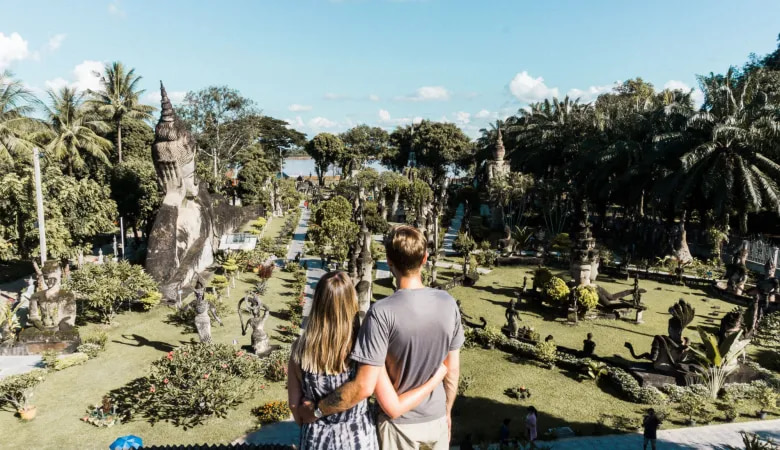
Visitor Information and Tips
Entry Fees and Operating Hours
The Buddha Park is open daily from 8:00 AM to 5:00 PM. Entrance fees are:
- Foreigners: 60,000 LAK
- Locals: 15,000 LAK (December 2024)
There may be a small additional fee for parking if you arrive by vehicle. While these fees are current as of December 2024, it's always recommended to check for the most up-to-date information before your visit, as prices can change.
What to Wear – Respecting Local Customs
As this is a spiritual site, proper dress shows respect:
- Wear clothes that cover your shoulders and knees
- Light, loose-fitting clothes work best
- Avoid revealing or tight outfits
- Comfortable walking shoes are a must
- Remove shoes when entering sacred structures
- A light scarf or shawl can be handy for extra coverage
Things to Carry for Your Visit
Pack these essentials for a great experience:
- Water bottle (stay hydrated!)
- Sun protection (hat, sunscreen, sunglasses)
- Small cash for entry fees and snacks
- Camera
- Light snacks
- Hand sanitizer
- Small umbrella or rain jacket (during wet season)
- Mosquito repellent
- Map or offline directions
Cultural and Historical Context of the Garden
The Vision of Luang Pu Bunleua Sulilat – The Creator of the Garden
Luang Pu Bunleua Sulilat, a charismatic shaman and priest, envisioned and built the Buddha Park in 1958. His spiritual philosophy blended elements of Buddhism and Hinduism, reflecting a syncretic approach common in the region. Bunleua Sulilat believed that understanding both belief systems could lead to enlightenment. This unique perspective is embodied in the park's diverse collection of sculptures. Forced to flee to Thailand after the communist takeover of Laos in 1975, he built a similar park, Sala Keoku, across the Mekong River, further showcasing his artistic and spiritual vision.
Blend of Myths and Religious Narratives in the Sculptures
The park's sculptures depict a fascinating array of figures drawn from Buddhist and Hindu mythology and cosmology. These include depictions of the Buddha, Hindu deities like Indra and Shiva, demons, mythical creatures, and humans. Each sculpture tells a story, often representing moral lessons, karmic consequences, or stages on the path to enlightenment. This rich tapestry of narratives creates a captivating and thought-provoking experience for visitors.
Insights into Lao Spiritual Practices Reflected in the Art
The Buddha Park offers a unique window into Lao spiritual beliefs and practices. The fusion of Buddhist and Hindu elements reveals the fluidity of religious traditions in the region. The emphasis on symbolic representation, visible in the sculptures, underscores the importance of visual storytelling in conveying spiritual concepts. While not a traditional temple, the park functions as a space for contemplation and reflection on life's deeper questions, offering visitors a chance to connect with their own spirituality.
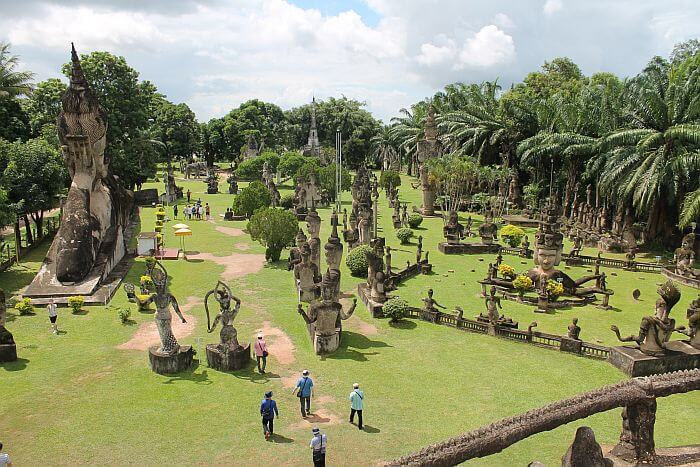
Nearby Attractions to Explore
Mekong Riverside – A Relaxing Spot Nearby
The Buddha Park sits near the banks of the mighty Mekong River. Take some time to relax by the river, enjoying the peaceful scenery and watching the boats go by. Several riverside restaurants offer refreshing drinks and snacks.
Vientiane’s Must-See Temples and Markets
Vientiane, the capital city, is a short trip from the Buddha Park and offers a wealth of cultural experiences. Explore ancient temples like Wat Sisaket and Wat Phra That Luang, and experience the vibrant atmosphere of Talat Sao (Morning Market) and the night market along the Mekong.
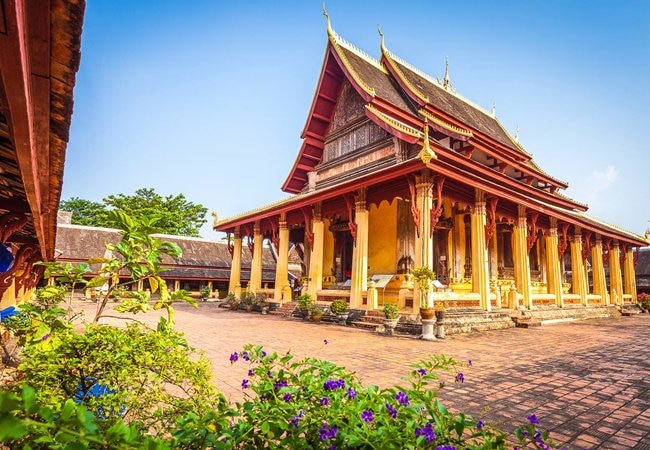
Local Restaurants for Authentic Lao Cuisine
Laos boasts a delicious and diverse cuisine. Near the Buddha Park and in Vientiane, you'll find many restaurants serving authentic Lao dishes. Try flavorful laap (minced meat salad), sticky rice, and fresh spring rolls. Ask locals for recommendations to discover hidden culinary gems.
Sustainable Tourism Practices at the Buddha Statue Garden
Supporting Preservation Efforts Through Responsible Tourism
- Respect the sculptures: Avoid touching or climbing on the sculptures, as this can cause damage.
- Stay on designated paths: Help protect the environment by staying on the marked pathways.
- Dispose of trash properly: Keep the park clean by using designated trash bins or carrying your litter with you.
- Support local businesses: Buying souvenirs and snacks from local vendors helps support the local economy and sustainable tourism.
Dos and Don’ts to Respect the Spiritual Site
- Do: Dress respectfully, covering your shoulders and knees.
- Do: Speak softly and maintain a respectful atmosphere.
- Do: Remove your shoes when entering designated areas.
- Don't: Litter or damage the sculptures.
- Don't: Climb on or deface the statues.
- Don't: Disrupt the peaceful environment with loud music or behavior.
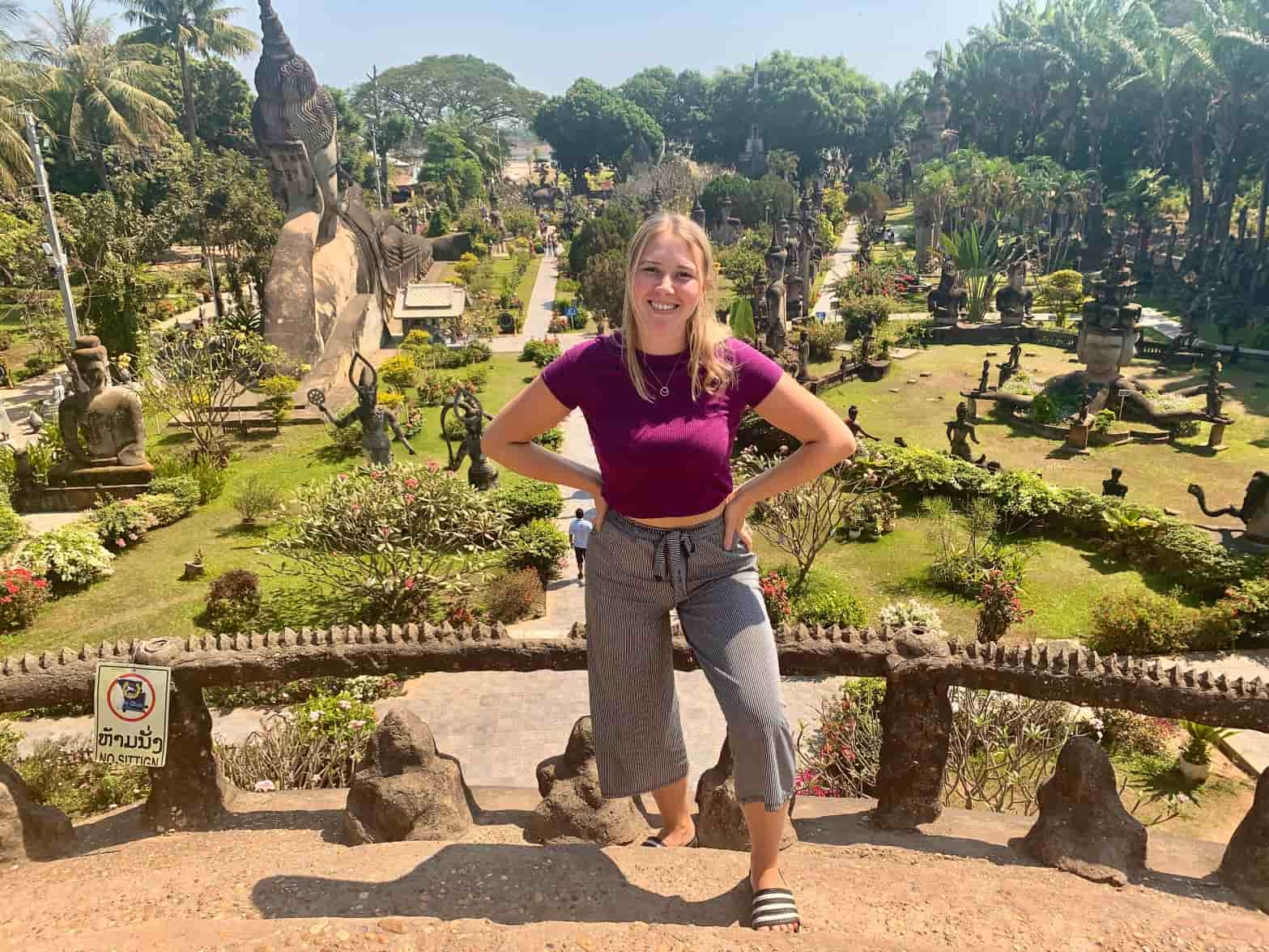
Conclusion – Why the Buddha Statue Garden Is a Must-Visit
A Blend of Art, Spirituality, and Tranquility
The park's diverse collection of sculptures, set against the backdrop of the Mekong River, creates a serene and contemplative atmosphere. Whether you're drawn to the artistic beauty, the symbolic meaning, or the peaceful setting, the Buddha Park offers something for everyone. It's a place where you can connect with your own spirituality, appreciate the fusion of Buddhist and Hindu traditions, and admire the unique vision of its creator.
Final Tips for an Enriching Experience
- Allocate ample time: Allow yourself enough time to fully explore the park and appreciate the details of each sculpture.
- Hire a guide (optional): A local guide can provide valuable insights into the history, symbolism, and cultural context of the park. For a seamless and enriching experience, consider exploring Laos tour options offered by reputable travel agencies like Threeland Travel.
- Engage with the local culture: Interact respectfully with locals, try Lao cuisine, and learn a few basic Lao phrases to enhance your experience.
- Reflect on your journey: Take a moment to reflect on the symbolism and spiritual significance of the sculptures, allowing the experience to resonate with you on a deeper level. The Buddha Park is more than just a tourist attraction; it's a journey of discovery. Planning your trip with a knowledgeable travel partner like Threeland Travel can help you maximize your time and create lasting memories.
FAQs About the Buddha Statue Garden
Is the Buddha Statue Garden suitable for families?
Yes, the Buddha Park is generally suitable for families. Children often enjoy exploring the unique sculptures and the "Pumpkin Tower." However, be mindful of the uneven terrain and steep stairs within the tower. It's also important to keep children under supervision and remind them to be respectful of the sculptures and the spiritual nature of the site.
Are guided tours available at the site?
While guides are not always readily available at the entrance, you can often hire a guide in Vientiane or pre-book a guided tour. A guide can enhance your visit by providing valuable insights into the history, symbolism, and cultural context of the park.
Can you combine the Buddha Garden visit with other Laos attractions?
Absolutely! The Buddha Park's proximity to Vientiane makes it easy to combine with other attractions in the capital city and surrounding areas. Popular options include visiting temples, markets, and exploring the Mekong River. Many tour operators offer combined tours that include Buddha Park and other nearby destinations.










